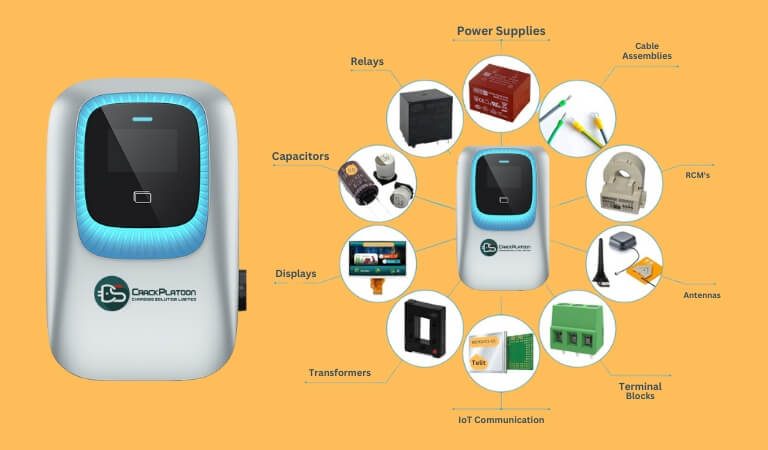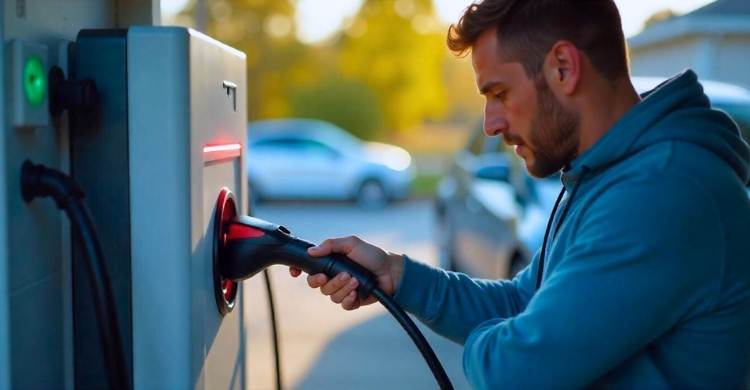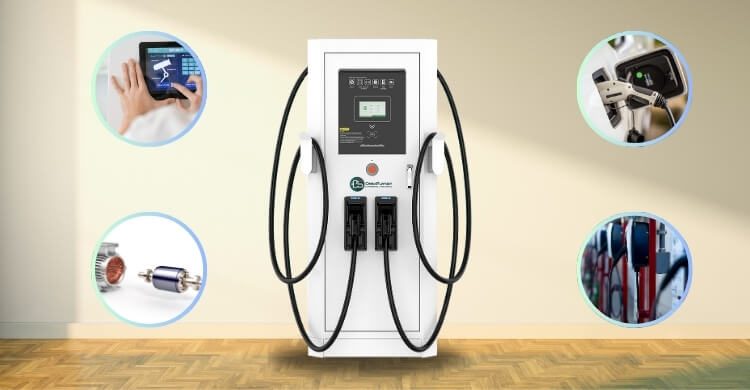Electric vehicle (EV) chargers are essential tools for powering up electric cars, providing a sustainable solution to keep your vehicle running smoothly. As the EV market continues to grow, knowing the technology behind these chargers becomes more important. Now you might ask, “What are the main components of EV chargers?”
The main components of EV chargers are the power supply, charging cable, connector, control board, and user interface. Each part plays a crucial role in delivering safe, efficient, and reliable charging to electric vehicles, as well as communicating properly and keeping power flowing through the system.
If you would like to learn more about how these parts work together, the technology behind them, and how important they are in creating a seamless EV charging experience, keep on reading.
What Are the Main Components of EV Chargers? The Tech Behind EV Charging
Electric cars need chargers to keep them running. EV chargers have different parts that work together to charge the car. Let’s explore what each part does and why it matters.

Power Supply
The power supply is the main source of electricity for the EV charger. It takes power from the electrical grid and passes it into the charger. This component controls the amount of electricity entering the system, keeping it steady and safe. It also protects the charger from sudden changes in power, like spikes or drops. Without the power supply, the charger wouldn’t have the energy it needs to send to the vehicle.
Charging Cable
Charging cables connect the charger to electric vehicles. It carries electricity from the charger directly to the car’s battery. Cables come in different lengths and types, depending on the charger and vehicle. A strong, well-made cable must be able to handle high levels of power without overheating. It should also be safe to touch, flexible, and easy for the user to handle.
Connector
A connector connects to the charging port of an electric vehicle. It attaches to the end of the charging cable and must fit the vehicle properly. Different EVs may require different types of connectors, so it’s important to use the correct one. Using a secure connector ensures that electricity flows smoothly and safely without causing damage or interruptions. It plays a key role in making sure the charging process goes smoothly.
Control Board
Control boards are the brains of electric vehicle chargers. It manages the entire charging process from start to finish. This board checks that the charger and the EV are properly connected before sending power. It also controls how much power is delivered and at what speed. Without the control board, charging might be unsafe or stop working correctly.
User Interface
Chargers have a control panel or screen that serves as the user interface. It allows the user to start or stop charging and shows useful information like charge time or battery level. In countries like Bangladesh, where electric mobility is growing fast, having a simple interface is very important. So, it is important for an EV charging service provider in Bangladesh to focus on user-friendly designs that keep their customers charged without confusion. A good user interface makes the charging process clear and user-friendly.
What to Do if an EV Charger Component Fails?
Chargers for electric vehicles are vital tools for powering your vehicle, but sometimes one or more of their components might fail. Knowing what to do in these situations can help resolve the issue quickly. Here’s a guide on what steps to take when a charger component isn’t working properly.

Check the Power Supply
Start by checking the power supply to ensure it’s working. Make sure the charger is properly plugged in and connected. A simple power outage or tripped breaker could be the cause. Resetting the charger or switching to a different outlet can help resolve the issue.
Inspect the Charging Cable
A damaged cable can cause charging problems, so check it for any visible wear, like cuts or frays. A functional cable should be intact, without exposed wires. If there is no damage, but the cable still doesn’t work, try using another one. Replacing a faulty cable is necessary to avoid further damage to the system.
Examine the Connector
The connector needs to fit snugly into the car’s charging port. Dirt or debris can interfere with the connection, so cleaning both parts is important. Over time, connectors can wear out and may need replacement. Ensure the connector is secure and works smoothly with your EV.
Check the Control Board
Power flow can be disrupted by a malfunction in the control board that manages the charging process. If your board is faulty, you may need to hire a professional to inspect it or replace it. Make sure the board is free from dust and debris that could affect its performance. Never attempt to fix the control board without proper training.
Inspect the User Interface
If the user interface isn’t working, there might be a problem with the screen or settings. Turn off and restart the charger to refresh the system. Double-check the settings to make sure nothing was accidentally changed. A broken or malfunctioning interface may need repair or replacement by a professional.
Contact a Professional
When simple troubleshooting doesn’t solve the issue, it’s time to reach out to a professional. An expert technician can properly diagnose and repair any electrical problems. Avoid attempting complex fixes yourself, as this could be dangerous. Professional help ensures the charger works safely and efficiently again.
Is It Possible to Customize the Components of an EV charger?
Yes, it is possible to customize the components of an EV charger. Many chargers offer features that can be adjusted. Customization options depend on the charger’s brand and model. You can choose the cable length, power capacity, or connector type for a better fit.
Customization is helpful when adapting the charger for a specific vehicle or location. For example, some cars require unique connectors. Some chargers allow you to adjust the control board settings. Additionally, the user interface can be customized to improve ease of use.
However, customization might need expert knowledge or professional help. It’s essential to ensure that the changes do not impact safety. Some parts, such as the power supply, may have limitations. Always consult the manufacturer before making adjustments to keep the system safe and effective.
Why Not All EV Chargers Are Internally Built the Same?
Electric vehicle (EV) chargers may look similar on the outside, but inside, they can be very different. These differences exist for good reasons. Let’s explore why all EV chargers aren’t built the same on the inside.
Different Charging Speeds
EV chargers may look alike externally, but their internal components differ significantly. For example, level 2 EV charger specifications allow for faster charging with a higher power output, reducing charging time. Differences in cooling systems, safety features, and efficiency also contribute to the performance variations between chargers.
Power Supply Variations
Not all chargers use the same kind of power supply. Some use alternating current (AC), while others use direct current (DC). The type of power supply affects how the charger works inside. That’s why their internal builds are often different.
Connector Compatibility
Vehicles support different types of charging connectors. Chargers must be built with the right connector type to match the vehicle. Internal systems are adjusted for that match. This ensures a smooth and safe connection every time.
Smart Features and Technology
Many EV chargers come with smart features like mobile apps or automatic power control. These features need extra internal parts to work. Chargers without smart features have simpler systems inside. The difference depends on what the charger is made to do.
Safety Requirements
Safety rules are not the same everywhere. Some countries need extra safety systems inside chargers. These added parts change how the charger is built. Different safety levels mean different internal designs.
Cost and User Needs
Some chargers are made to be budget-friendly, so they use fewer or simpler internal components. Others are built for high performance. User needs often decide how the charger is designed. This affects how it works and what’s inside.
Can EV Chargers Components Be Recycled or Reused?
Yes, EV charger components can be recycled or reused depending on their condition and the materials used to make them. Many parts, like metal casings and cables, are made from recyclable materials. Plastic covers and wiring can also be sorted and processed. Recycling helps reduce waste and supports a cleaner environment for everyone.
Some components may still work and can be reused in other chargers or systems. Control boards, if not damaged, can often be tested and used again. Connectors and cables are sometimes removed and installed in newer units. Reusing good parts can save money and lower the need for new materials.
However, not every part is safe to reuse or recycle without care. Damaged or worn-out components should be checked by a technician first. Chargers must meet safety rules, so only working parts should be reused. Always follow proper recycling steps or ask a certified service center for help.
EV Charging Component Demand: How Does Government Policy Affect It?
Governments play a big role in shaping the future of electric vehicles. Their rules and plans can raise or lower demand. Let’s explore how policies affect the need for EV charging components.

Subsidies and Incentives
When governments offer subsidies, more people buy electric vehicles. Higher EV sales increase the need for charging stations and components. Incentives also help businesses install more chargers. This creates steady growth in demand for related parts and systems.
Local Manufacturing Support
Some countries support local factories to build EV charger components. Policies like tax cuts help companies lower their costs. Encouraging local production boosts demand for raw materials. It also creates jobs and strengthens the charger supply chain.
Environmental Laws
Stricter environmental laws push people toward cleaner energy choices. Electric vehicles help meet those goals with zero tailpipe emissions. Governments promote chargers to support this green switch. More chargers mean higher demand for important components inside them.
Public Charging Projects
Governments often build public EV charging stations in cities and towns to support growth. Especially countries like Bangladesh are seeing growth in their electric vehicle market, which drives the need for more chargers. As the electric vehicle market in Bangladesh grows, more charging stations are required. This creates a steady demand for EV components and infrastructure.
Import and Export Regulations
Rules on importing parts can raise or lower their cost. Easier import rules help meet demand by allowing more options. Export limits may also impact global supply chains. These regulations affect how companies plan for charger component demand.
Standardization Policies
Standard rules help ensure all chargers work with different vehicles. Governments push for common plug types and charging systems. This leads to more production of standardized components. Such policies help increase demand in a more organized and efficient way.
FAQs About What Are the Main Components of EV Chargers?
Chargers for electric vehicles may appear simple on the outside, but they contain several working parts that allow safe charging. If you’re curious about the details, functions, and practical concerns related to these components, this FAQ section will help. Here are some answers to common questions that go beyond what we’ve already discussed.
How Does an EV Charger Stay Safe During Power Surges?
EV chargers are built with protective systems like surge protection and circuit breakers. These features guard the internal parts from sudden voltage spikes. If the power supply detects unusual flow, it stops the charging process. This keeps the car and charger safe from damage.
What Materials Are Used in EV Charger Components?
Most EV charger parts are made from durable materials like copper, aluminum, plastic, and heat-resistant rubber. The cable uses copper for conductivity. The casing and interface are made from strong plastics. These materials are chosen for safety, strength, and long-term use.
Can Smart Features Be Added to Basic EV Chargers?
Yes, some chargers allow software upgrades to add smart features. These include app control, scheduling, or usage tracking. However, the control board must support these functions. If it doesn’t, the entire system may need upgrading.
Why Do EV Chargers Need a Cooling System?
Chargers generate heat while delivering power. A built-in cooling system, like a fan or heat sink, keeps temperatures stable. Without cooling, parts may overheat and fail. Proper heat management ensures performance and protects the internal components.
Do All Control Boards Work the Same Way?
Not all control boards function identically. Some offer advanced features like automatic load balancing or smart metering. Others are basic and only manage charging flow. The design depends on the charger’s level and intended use.
How Long Do EV Charger Components Last?
Most EV charger parts last 7–10 years if used properly. High-quality components may last longer. Regular maintenance helps extend lifespan. Environmental conditions like heat, dust, or moisture can affect durability over time.
Are EV Charger Connectors Weatherproof?
Yes, many connectors are weatherproof and designed for outdoor use. They have protective seals to block moisture and dust. However, not all are built the same, so always check the IP rating. Higher ratings mean better protection in harsh conditions.
Bottom Line
Charging infrastructure plays a key role in ensuring that electric vehicles operate safely and efficiently in the future. There are several key components that work together to make them perform well. Identifying what are the main components of EV chargers? Helps users appreciate how the power supply, charging cable, connector, control board, and user interface all function as a unit. Each part has a specific role—from managing power flow to ensuring smooth user interaction.
Whether it’s for daily use, customization, or repair, knowing these components adds real value. As EV adoption rises in places like Bangladesh, the demand for reliable chargers grows. So, it is important to choose, maintain, or recycle the right parts to ensure safety and sustainability. In the future, a well-designed charger will support a cleaner, smarter future, which will keep electric vehicles running smoothly.
